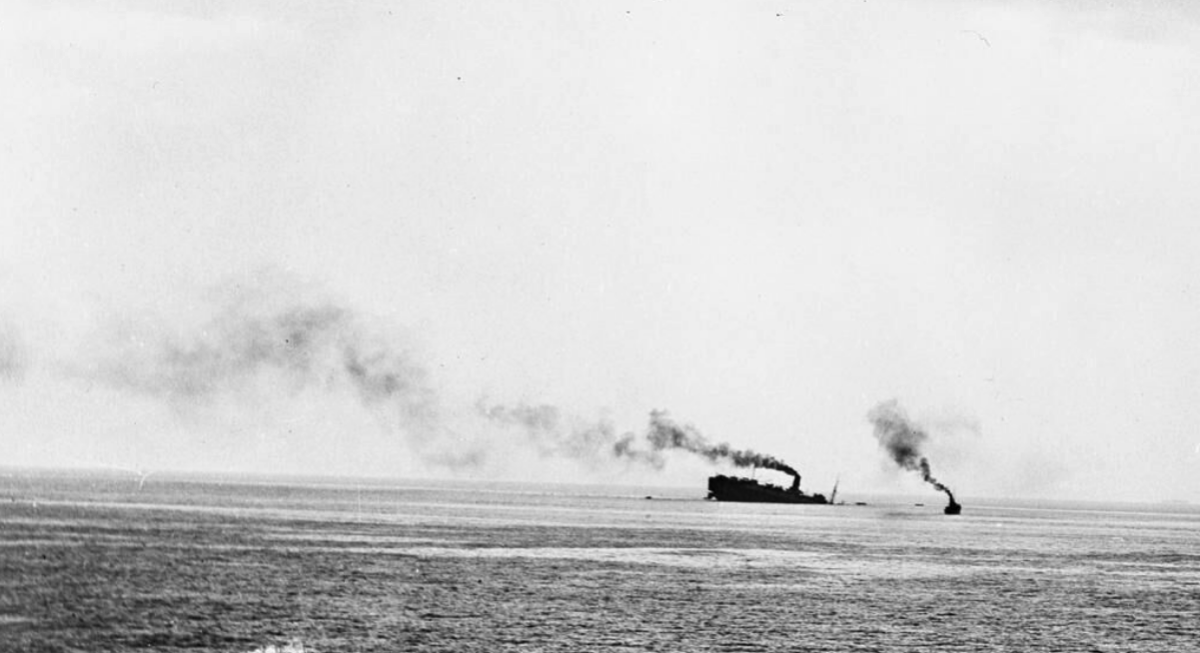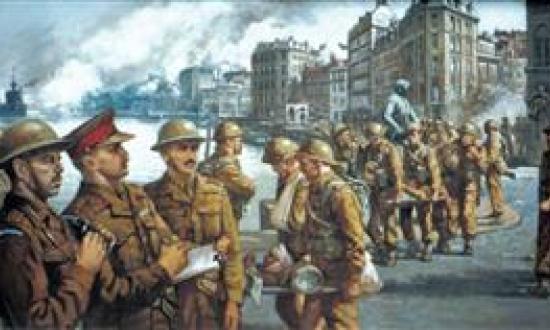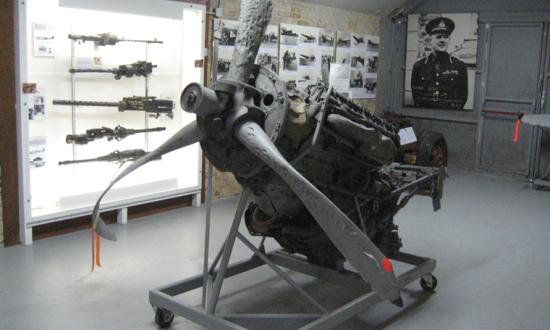June 1940 was a month that changed the course of the Second World War. It was both Britain’s darkest hour and witness to a tragedy that remains little known to this day—a tragedy that changed my family forever.
As a child growing up in Britain in the 1990s, my sister and I every so often would be left with my grandmother, Claire. A tiny, frail woman, Claire lived in a terrace house in the oldest part of Swindon (an area locals these days refer to colloquially as “Old Town”).
Owing to Claire’s serial chain-smoking ways, a stale cigarette odor lingered in every nook and cranny. To avoid the unpleasant smell, I usually would eat meals in the back garden. I can picture it clearly: me eating tinned meatballs, Claire sipping reheated coffee while lighting herself yet another cigarette. By that point in her life, Claire rarely had much of an appetite except on the rare occasion she would pour a cup of leftover lukewarm coffee over a bowl of Kellogg’s corn flakes, garnished of course with raisins.
With the nostalgic music of Vera Lynn audible from inside, I would ask Claire all about “The War.” She always referred to World War II as “The War,” such was the overbearing impact the conflict had on her and, by extension, our life. Claire would recount to me her experiences as a young woman working with what was then known as the Auxiliary Territorial Service, which tasked women with a range of vital roles during the war. In my grandmother’s case, she was charged with assisting antiaircraft operations. It was one conversation in particular, long buried in my subconsciousness, that would suddenly return to me decades later.
(Courtesy of the Author)
Claire had told me that she had decided to sign up for the war effort following news that her older brother, Colin, serving as a soldier in France, was missing in action. I distinctly remember asking Claire what happened to him. Looking in the distance, as if talking more to herself than me, she described how Colin had been on board a ship that had been bombed by the Luftwaffe, and his body had never been recovered. She said there was a grave somewhere in France, but “of course, there is nothing beneath it.” As far as I recall her saying, no one had visited it.
Claire passed away shortly after sharing that story. Decades went by, and Colin’s story retreated to the far recesses of my mind. That is, until a hot summer’s day in August 2019. I was on the New York subway, traveling to where I now work, listening to an audiobook about a journalist trying to recover the remains of an American soldier who had died in Japan during World War II. The journalist was explaining that official U.S. policy holds that the government is committed to recovering the remains of any and all American soldiers who died during the course of duty.
Suddenly, my mind lit up. I could hear Claire’s words retelling Colin’s fate, along with many unanswered questions. How exactly did Colin die? What ship was he on that was bombed? Where is his grave, and the ship, now? And why didn’t anyone in my family seem to know the answers?
I spoke with both my dad and his older brother - my uncle Ian - as a starting point. Unfortunately, they knew little more than what Claire had told me decades ago. Ian told me that he remembered someone once telling him that Colin had died during the British evacuation at Dunkirk, apparently due to the betrayal of a shipmaster who had given the ship’s departure time and location to the Germans. But he admitted his recollection might not be accurate. It was simply the case, they both told me, and in a departure from today’s tendency to overshare, that those who served in The War did not discuss these things in too much detail even with their children.
My own research quickly hit a dead end. The Commonwealth War Graves Commission (CWGC), generally pretty comprehensive and accessible online, had no trace of a “Colin Thomas” born in 1918 and with recognizable parents. It was like he never existed.
Then finally, one Saturday evening, late into the night, I realized my error—an error based on a very simple oversight, and yet one that, remarkably, no one else had picked up on either. My mum had sent over scans of a very old black-and-white photo of a four-month-old Colin, dated June 1918, that she found among Claire’s old possessions. Only it had “Baby John Colin Lee Thomas” written on the back. Aha! Although it seems he went by Colin all his life, his full name had been lost to history. Armed with this new information, I went back to the CWGC archives and just minutes later I was staring at a picture of what appeared to be my grand-uncle’s name on a memorial plaque at the Commonwealth War Graves section of Dunkirk Town Cemetery.
“I’ve found him. . .” I remember murmuring out loud to my housemate as I scrolled down. There he was: Private John Colin Thomas, died 17 June 1940, aged 22, son of John Weldon Thomas and Amy Thomas, of Hall Green, Birmingham (my great-grandparents).
On the surface at least, it seemed like my uncle might have been right. Judging by the location of his memorial plaque, had Colin died in the Dunkirk evacuation? Not quite. Some quick Googling revealed that the final evacuation from Dunkirk had taken place on 4 June, 13 days prior to when Colin had officially died. Something wasn’t right.
Further digging eventually revealed that Colin had actually “died” some 335 miles south of Dunkirk, off the coast of the small port town of Saint-Nazaire, on board the RMS Lancastria, the sinking of which, as I soon would discover, remains the largest single loss of life in British maritime history. Indeed, more people died in this tragedy than from the sinking of the Titanic and Lusitania combined. Now that I had found my uncle, I dove into the Lancastria’s story, a story I ashamedly hadn’t even known the existence of.
The Lancastria was a 16,243-ton, five-decked ship that, up until the outbreak of war in 1939, had been a lavish luxury cruise liner. She toured the Norwegian fjords and across the Mediterranean and West Indies before being hastily requisitioned by the British government and outfitted as a troop ship. She spent the early months of the war ferrying soldiers back and forth from Canada to the U.K. and assisted in the evacuation of Norway before finally being called on to play a pivotal role in Operation Ariel—the name of the lesser known campaign that followed the aftermath of the evacuation of Dunkirk. The scenes leading up to it were no less dramatic.
Overwhelmed by the might of the Nazi blitzkrieg, French defenses had quickly collapsed in the days following the last departure from Dunkirk. Countless civilian refugees, French soldiers, and the vast remainder of British forces in France—some 150,000 men—hurriedly escaped south. On 14 June 1940, an urgent call went out to the crew of the Lancastria, then docked at Liverpool, to make all haste for the French port of Saint-Nazaire. That very same day, the Nazis occupied Paris. Things were dire.
Colin, I discovered, was by this point based at a weapons and equipment storage base at Nantes, the old historical capital of Brittany located about 40 miles from the sea. Having been an articled clerk prior to the war, Colin was one of many support troops, engineers, repairmen, transport and communications staff, wireless operators, air force ground crew, store minders, cooks, bakers, and clerks that supplied the main British Expeditionary Force. Known collectively as “the Grocers,” the vast majority of these personnel were located, at least initially, far behind the main defense lines, and most never would have expected to see conflict. Of course, few expected either that France would fall so quickly to the German onslaught.
In the wake of Paris’ capture, General Alan Brooke, the commander of all remaining British forces in France, pleaded with Prime Minister Winston Churchill to issue a general order for evacuation. During an intense 30-minute call in the early hours of 15 June, a desperate Brooke informed Churchill of the irreversible collapse in French morale, saying it “was impossible to make a corpse feel.” Churchill relented, and at 1000 that same morning, a general evacuation order was given. Later that day, word reached Colin's base in Nantes.
As those at the base hastened to depart, numerous reports document a rushed frenzy ensuing to burn and destroy any equipment, vehicles, and armaments that could not be carried out, to prevent them from falling into German hands. Meanwhile, others helped themselves to remaining food and drink stockpiles. As 19-year-old Henry Harding from Wales later would recount: “Everything was thrown open . . . you could help yourself to whatever it was you wanted, so we took chocolate.” Then, with German planes already in control of the skies above, they headed out to converge on what author Johanthan Fenby describes as “the last escape hatch left.”
Within the next 24 hours, Saint Nazaire was overcrowded with British soldiers and refugees. Local French citizens cried as the British began clambering aboard requisitioned ocean liners. It was into this scene of chaos that the Lancastria would arrive the next day, 17 June. It was to prove a fateful day.
More than 6,000 reportedly boarded the Lancastria with Colin’s corps among the very last to board. Those who had boarded first were greeted by men in fancy white uniforms with gold buttons, who assigned them all rooms. While they waited for others to board, a lucky few tucked into sausages, bacon, and eggs with hot buttered toast for breakfast. It must have been quite the comfort days after a hurried dash to the coast.
Eventually, though, the vessel was so cramped that officers pleaded with the Lancastria’s captain to take on no more. He pushed back, saying he had been ordered to take as many as possible without respect to international law. They were all anxious to leave. They had good reason to be. There had been reports of other ships being attacked by the Luftwaffe, although fortunately no major disasters had yet struck.
As thousands crammed onto the assembled ships, news was spreading in the port that France’s newly appointed leader, Marshal Pétain, had agreed that morning to open armistice talks with Germany. Across the English Channel, Churchill soon was meeting France’s emergent leader-in-exile, Charles de Gaulle, in the gardens of Number 10 Downing Street. While that same day, up in Belgium, Hitler was said to have hit his thigh in glee upon hearing the news of France’s capitulation. As Churchill would declare later that day, “The Battle for France was over.”
(Imperial War Museum)
After waiting painstakingly for its escort, the Lancastria finally began to pull out of the dock. Yet any relief those on board felt was quickly dashed, as shortly thereafter six Luftwaffe planes descended from the skies. A minute later the siren on the ship sounded, described as “a chilling banshee scream . . . howling from the sky.” Initial bombs missed, but a series of successive bombs hit their mark, with one payload going straight down the ship’s fennel. It was fatal. The ship went down in 20 minutes. Thousands on board perished.
To read the survivor accounts is harrowing. Collectively, they portray a scene straight from Dante’s Inferno. One 15-year-old who helped with the rescue described the scene he saw as “hell . . . abominable, the height of horror.”
We will never know for sure exactly how Colin died, and perhaps that is for the best. Most of those packed in the ship’s hold died instantly from the initial bomb explosion. Many others drowned, either because they couldn’t swim or were trapped. Only 2000 life belts were on board for at least three times that many men. Splinters of wood from walls and floors impaled people standing nearby. Oil flowed out of a ripped oil tank, and splinters shattered in the dining hall. Those who survived the initial sinking choked on the oil that flooded the surrounding waters. But most ghastly and cruelly, the Luftwaffe planes returned to gun down those swimming to shore.
One account stands out from the rest, however. A handful of soldiers, standing on the Lancastria’s rapidly sinking hull as she descended into the water, proudly and defiantly sang the wartime classics of “Roll Out The Barrel” and “There Will Always Be An England.”
Many of the bodies were never found or went down with the ship. Some 128 bodies came ashore. As a witness described the scene, “Out on the sea were hundreds of bodies, many past recognition, shot to pieces, machine-gunned or blown to pieces.”
I have discovered the initial telegram that was issued in the immediate aftermath of the Lancastria’s demise. Colin is listed as “Missing In Action.” It is hard to say exactly when my great-grandparents and Colin’s two sisters would have been notified. I do know that when they did, it left a deep scar on my grandmother, Claire, and a burning desire, in her words, “to kill Germans.” Colin was her hero, and in joining the defense forces, she was determined to ensure his death was not in vain.
(Courtesy of the Author)
Only in more recent decades has the story of the Lancastria become more known. Despite, or perhaps because of, the ship’s sinking accounting for more than a third of all losses in the war up to that point, and wanting to maintain British morale, Churchill felt justified in putting a censorship notice forbidding the media, and even survivors, from talking about it. After all, it must not have been hard to imagine England falling to the Nazi war machine. The Lancastria’s fate was kept so tightly under wraps that those who survived did not talk to wives and relatives about it until decades later.
It wasn’t until the 75th anniversary of the Lancastria’s sinking, in 2015, that the British Parliament formally acknowledged it. Standing in for the Prime Minister, George Obsborne said: “It was kept secret at the time for reasons of wartime secrecy, but I think it is appropriate today in this House of Commons to remember all those who died, those who survived, and those who mourn them.”
Unfortunately, it is the brutal reality that those who died during the sinking of the Lancastria have become one of the great untold tragedies of the war. Unlike Dunkirk, which has been permanently etched into mythology and continues to inspire British storytellers today, the stories of the 150 000 men left behind in France in the days following Dunkirk have largely been forgotten by the historical writers and storytellers of the Second World War.
Even among members of my own extended family I encountered indifference. I remember one of my dad’s cousins, Colin’s own nephew, replying curtly to a message I sent that no one ever spoke to him about Colin and that I probably knew more than he does.
I could not let the story end there, however. I thought about Claire all those years ago telling me about her beloved brother. And I thought of Colin’s memorial plaque in Dunkirk. It occurred to me that not one member of his family had visited it in the past eight decades. My dad said it was a shame he did not find this out in Claire’s lifetime. He would have taken her to see it. She couldn’t go, but we could.
So shortly before the 80th anniversary of the Lancastria’s sinking, my sister, dad, and mum took the ferry across the English Channel. At 0800 on a cold, misty, winter day, we visited the grave. We had taken with us a small bottle of whiskey. We poured each of us a small cup, and then a fifth one for Colin. Then, crouching to the small plaque, we raised a toast.
John Lee Colin Thomas, lost on the Lancastria on 17 June 1940. Lost but not forgotten.
(Courtesy of the Author)











